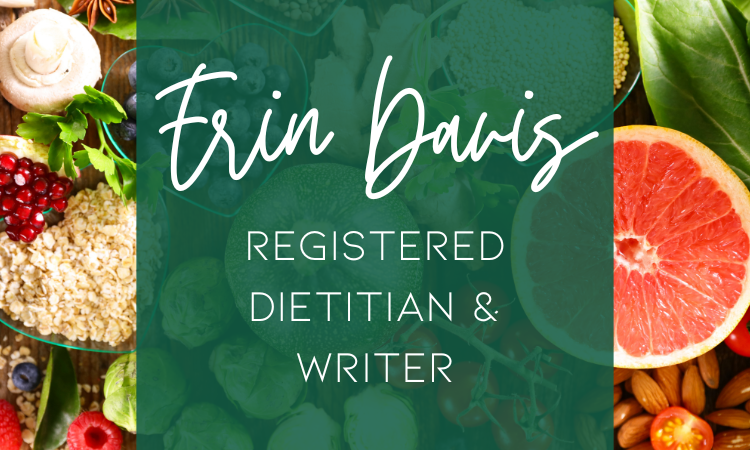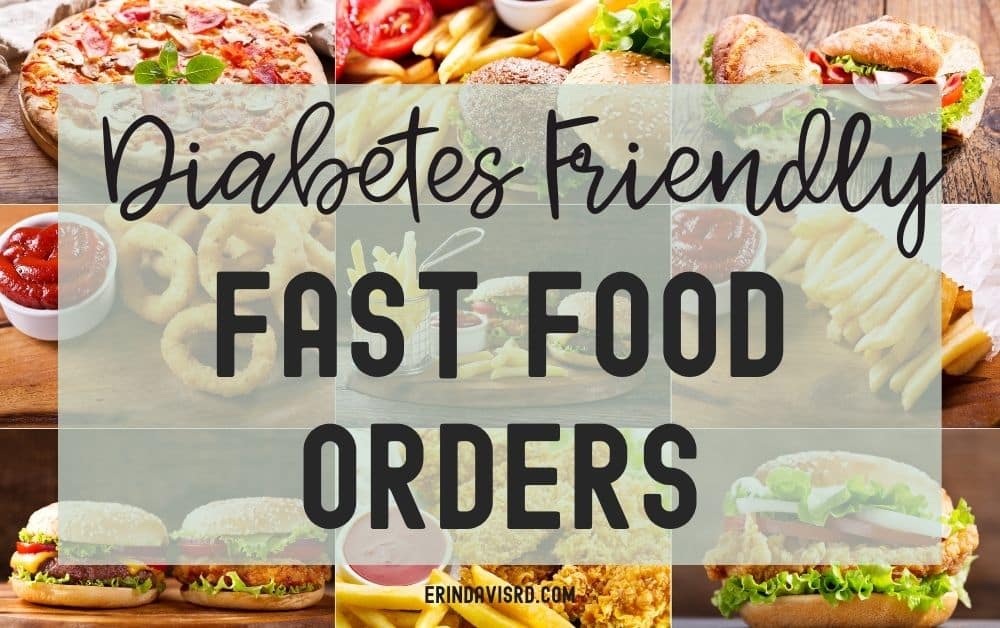Life gets busy sometimes, and fast food can be one of life’s great conveniences when you’re crunched for time. But what if you’re trying to keep your blood sugars within your target range? Here are some diabetes friendly fast food orders that won’t spike your blood sugars.
Whether you’re on a road trip or you’ve got a million things on your to-do list, sometimes you need to default to fast food.
Fast food gets a bad rap for its high-calorie, high-fat meals, served in extra large portion sizes. But there is usually something on the menu for everyone.
Yes, I said everyone—including people with diabetes. One major misconception is that you have to swear off certain foods when you are diagnosed with diabetes.
I’m a firm believer that you can make all foods fit, even if you have diabetes. Want to learn more about intuitive eating and diabetes?
The thing I never do is put people on “diabetic diets”. Forbidding certain foods, including fast food, only creates a negative relationship with food.
If you’re new here, welcome! I’m Erin, a registered dietitian and certified diabetes care and education specialist with a passion for intuitive eating and diabetes management.
An important step in becoming an intuitive eater is allowing yourself to eat all foods. That includes the food at your favorite fast food joint.
In today’s post, I’m covering how to create diabetes friendly fast food orders. With a little strategy, you can eat the foods you enjoy and hit your blood sugar goals.
Let’s jump in!
Please note: As an Amazon Associate, I earn from qualifying purchases.
Diabetes friendly fast food tips
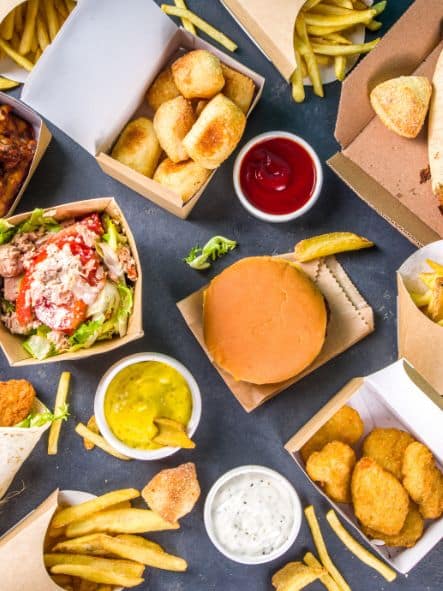
Just because you have diabetes doesn’t mean you have to avoid fast food forever. With some planning, you can choose foods that satisfy your hunger in a hurry—and will help you stay in your target glucose range.
Newsflash: You do NOT have to cut carbs completely out of your diet. You can get your blood sugars down without restriction.
Whether you’re eating at McDonalds or Taco Bell, there are foods on the menu that are high in protein, lower in simple carbs, and deliver added nutrients.
Here are some tips for choosing fast foods when you have diabetes:
1. Review the menu beforehand
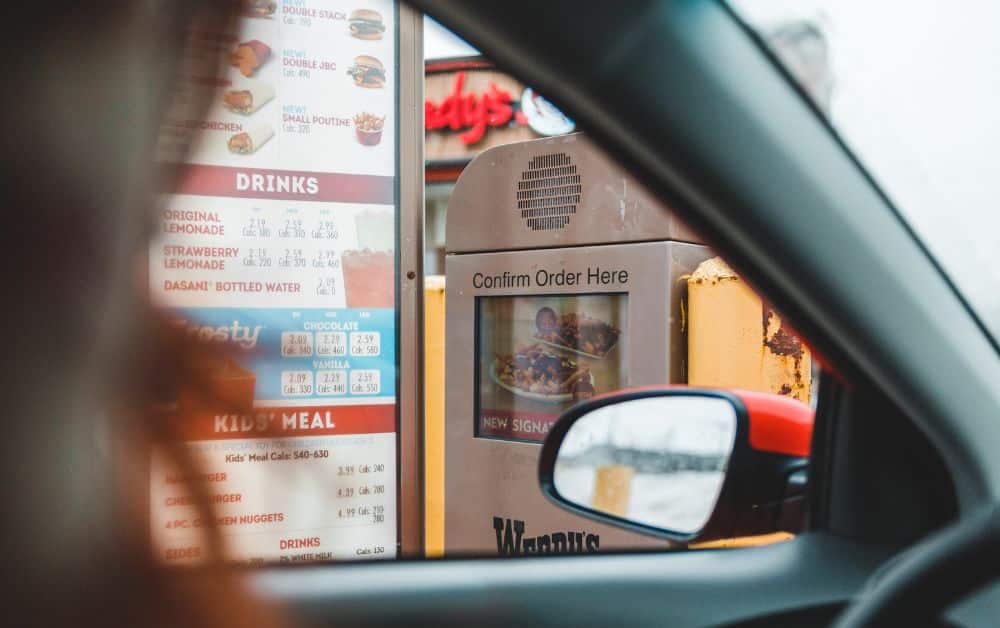
Most fast food restaurants publish their menus online so you can review the offerings and nutrient values of the food.
When you’re looking for foods that will help you balance your blood sugars, you want a combination of of macronutrients.
Macronutrients are carbohydrates, fat, and protein. There is no prescribed or perfect ratio for someone with diabetes.
According to the American Diabetes Association 2024 Standards of Care, diets should be individualized to develop a healthy eating pattern.
You aren’t limited to a certain number of carbs. But what you can do is choose carbohydrates that are high in fiber, vitamins, and minerals.
The same goes for fat and protein. No specific amount of grams that you need to hit or stay under. Fat and protein are the nutrients that will help you stay full, so these are key for every meal.
2. Stick with carbs from food
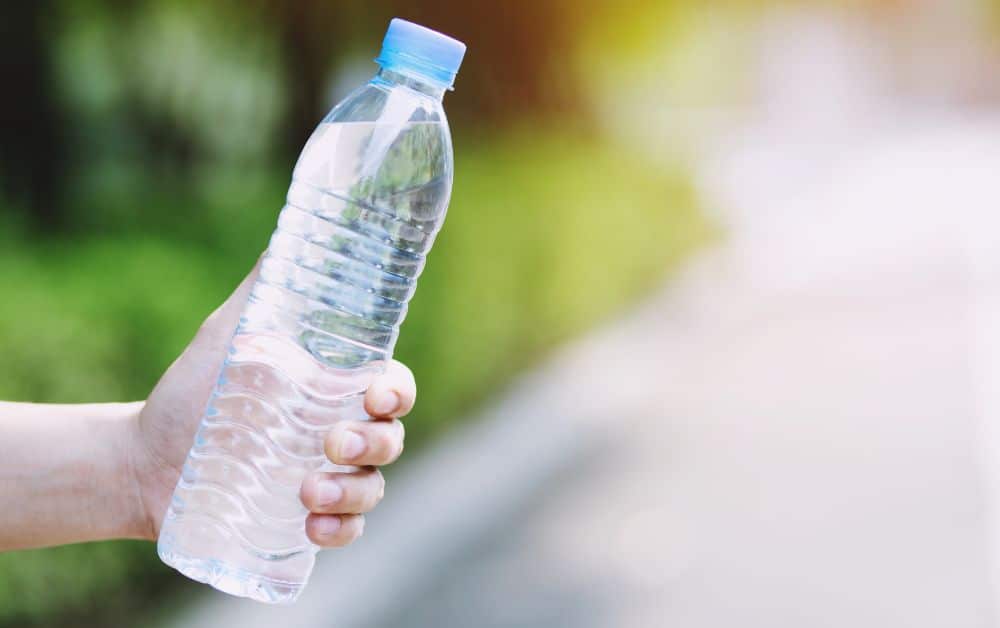
My next tip is to limit carbs from beverages. If you’re going to enjoy a burger with a bun and an order of fries, skip the soda.
It’s all a balancing act. Here’s the thing, the carbs that you get from beverages, whether a slushy, soda, or sweetened coffee drink, will not add many nutrients to your overall intake.
Besides sugar, there isn’t much else in a soda. So it’s likely not worth the high blood sugar that may follow drinking one.
There’s always water. Or diet soda.
I’ve done a deeper dive into artificial sweeteners and alternative sugars, and while I’m not comfortable recommending diet soda for very regular consumption (like multiple times a day), I think they’re perfect for when you’ll be getting plenty of carbs from your food.
Now if fountain coke is your absolute favorite and that’s what you’re craving, then by all means have it. But you’ll need to then choose foods that are lower in carbs and higher in protein and fat.
Again, it’s all about the balance.
3. Balance your meal
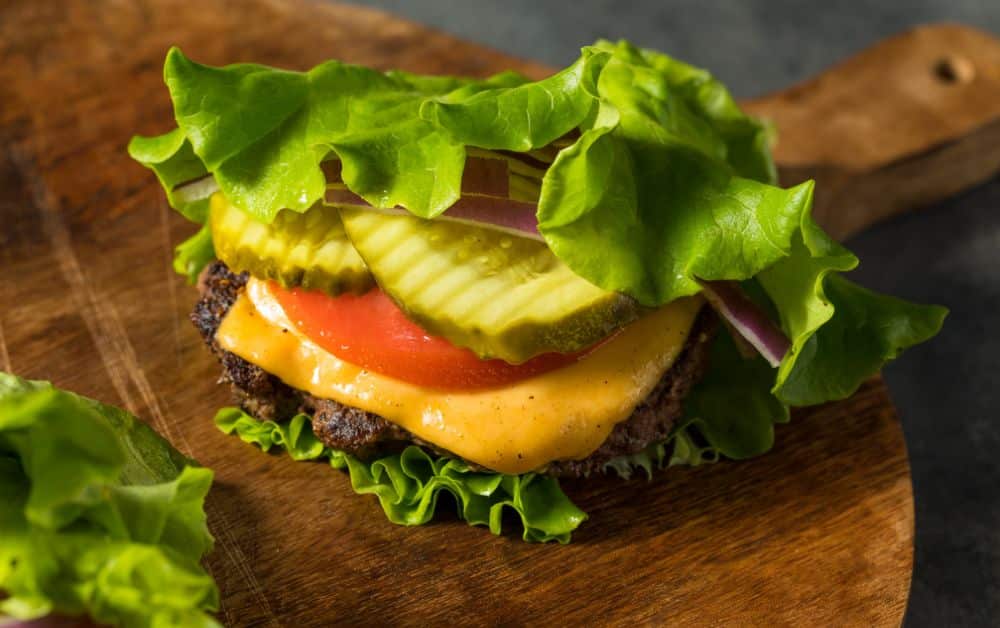
Speaking of balance, how do you find it?
This is an individual thing. You likely know how your blood sugar responds to certain foods.
So you can probably imagine what it would do if you had KFC chicken, mashed potatoes, mac and cheese, a biscuit, and soda, right?
How would I balance that meal? It depends on what I craved the most. I repeat, this is personal.
- First, I’d eat a chicken breast vs. chicken wings, so I’d get more protein with less breading.
- Then I’d add a side salad or green beans to get in some veggies.
- The mashed potatoes are delicious, so I’m definitely eating those.
- Next, I’m not super crazy about mac and cheese or biscuits, so I’d likely skip those.
- And I’d have water instead of soda.
This is just an example. Using nutrition information from the restaurant, I’d try to choose a combination of carbs, fat, and protein.
The goal of the meal is to be full, satisfied, and nourished. And while not every meal has to be nutrient-packed, food is fuel. I try my best to make the most of each opportunity.
4. Choose a practical portion size
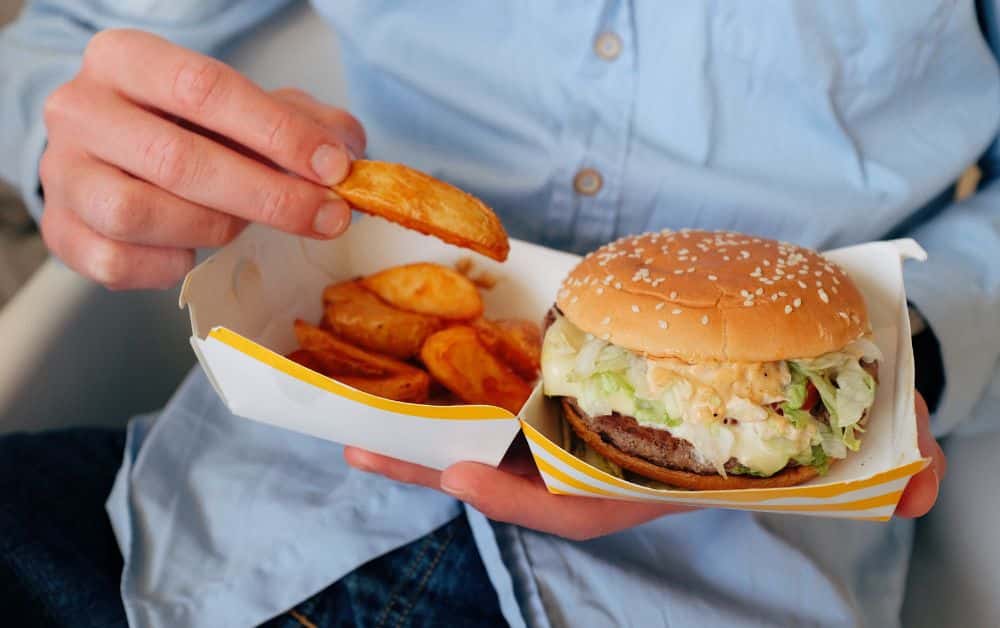
All throughout high school, I had the same fast food order. Two cheeseburgers, medium fry, and medium drink.
I almost always wasted the second burger, but it was just my order.
As a wiser, more frugal adult, I order smaller portions. It turns out that the smaller portions satisfy me just fine.
Fast food portions are often much larger than I’d eat at home. Rarely would I ever need two burgers to feel satisfied.
Do you have a regular order that you rarely stray from? It doesn’t make sense that we order the same thing, even when our hunger levels vary.
I want you to experiment with reducing the portion—especially on days when you aren’t extremely hungry.
If you always get a large fry, try a small and see if you’re still satisfied. Always get three tacos? Try two and see what happens.
What’s the worst that can happen? You’re still a bit hungry and you need to go back for more? That’s okay, give yourself permission.
5. Eat mindfully

Part of eating smaller portion sizes is being in tune with your fullness cues. Never feel full? Mindful eating is the answer.
I know you’re eating fast food because you’re in a hurry, but I am asking that you take 10-15 minutes out of your day and pay attention to this meal.
On your way to a baseball game or meeting? Don’t eat while driving. Instead, try to carve out 10 minutes to eat your food. Shut out distractions and taste your food.
Do your best to eat slowly. I’ve got some other tips for mindful eating. But bottom line is when you eat without distractions, you’re more likely to enjoy your food…and feel satisfied.
6. Add veggies
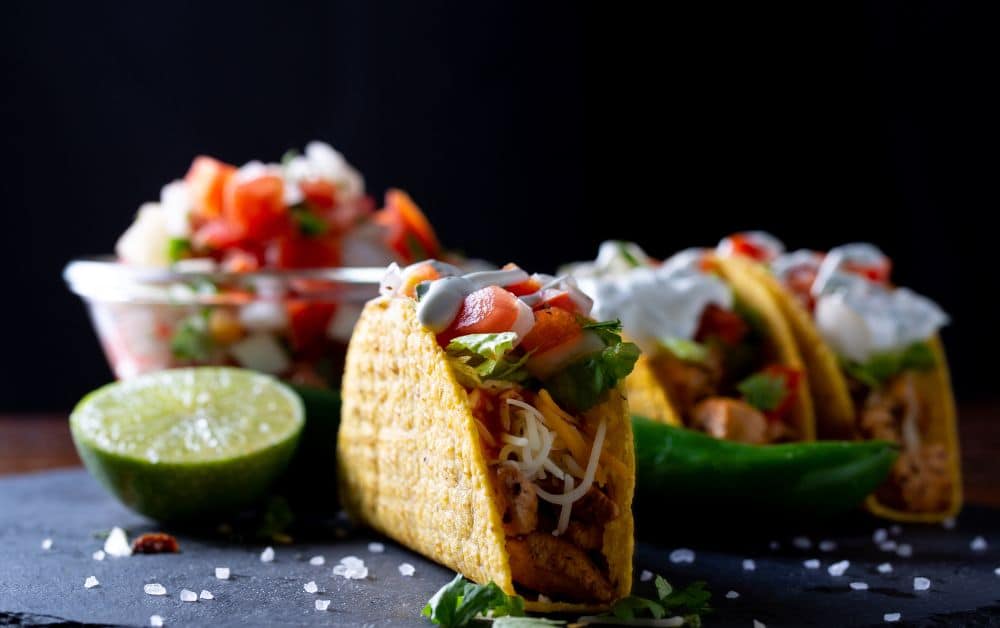
Let’s face it, we all could use more veggies in our diet. Vegetable-heavy diet patterns like the Mediterranean and DASH diet for diabetes stand out as front runners for achieving health benefits.
Maybe you have access to fresh fast foods, like a deli or salad bar. That’s wonderful.
But if you’re hitting up the typical fast food joints, you can always add veggies to your order.
Add a side salad. Top your burger with veggies. Double up on pico and black beans when you’re eating tacos.
7. Adjust insulin accordingly
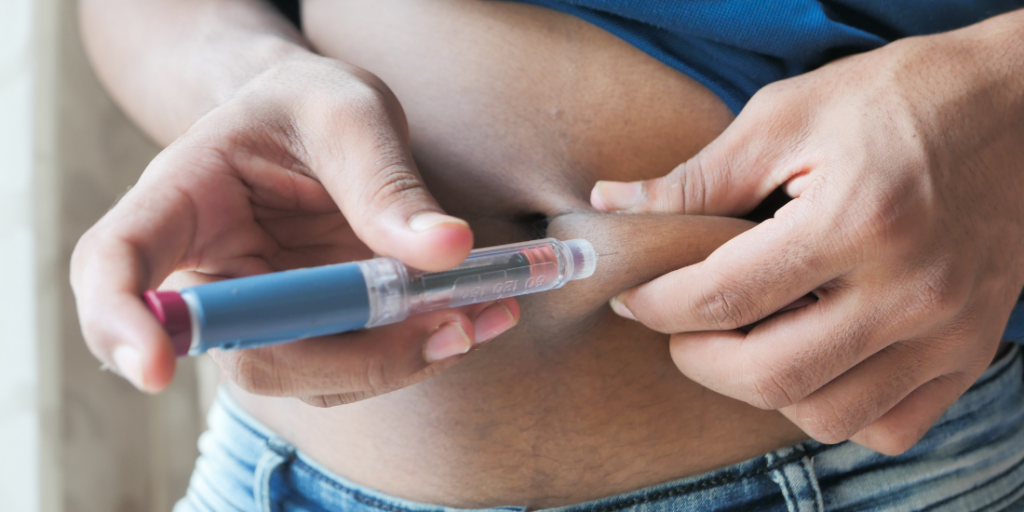
Of course, you can always use the nutrition facts to count the carbs and dose insulin. But there is something else to consider when it comes to fast food and insulin use.
Fast food may have a bit more fat than you’d normally eat.
Fat is slow to digest and can cause a delayed increase in your blood sugars. That means your one or two hour post meal glucose levels may be higher than normal.
No need to be alarmed. Just adjust. If you use a pump, you may need to use an extended bolus to cover that slow rise in glucose.
I strongly suggest working with your diabetes care team to determine proper adjustments in your insulin dose.
Diabetes friendly fast food orders
If you’re looking for diabetes friendly fast food orders, here it is. The following are my recommendations as a registered dietitian and certified diabetes care and education specialist (who is anti-diet!).
McDonald’s
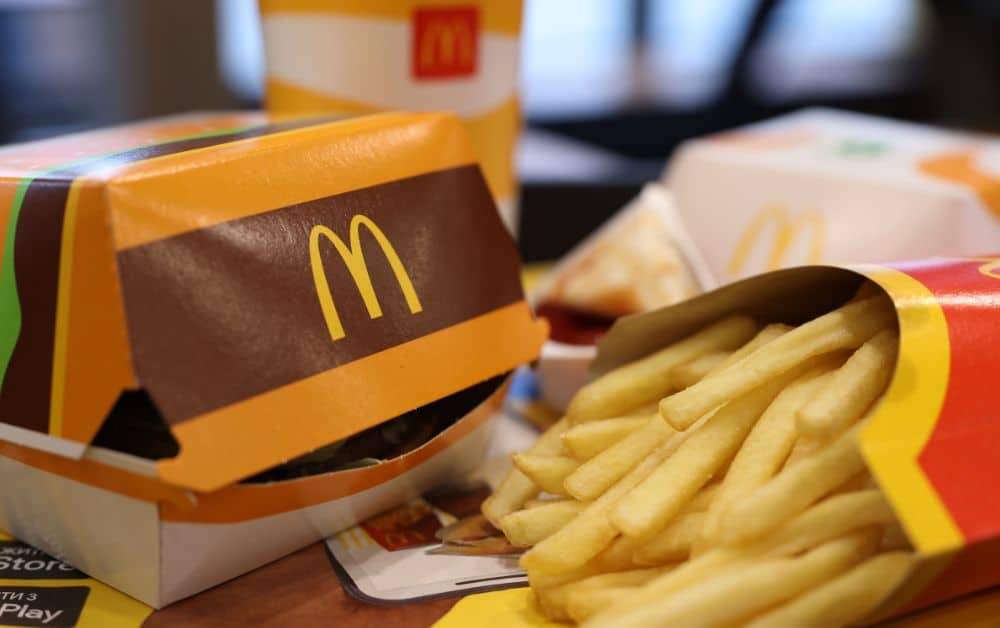
This is my boys’ favorite fast food stop. So if I have to get something from here, I’ll try my best to make it balanced.
You can always lower the carb count of a burger by removing the bun and getting a large piece of lettuce instead. Most burger places will do that for you without batting an eye.
The downside is that they don’t have many vegetable options, besides adding iceberg lettuce to your sandwich.
Like I said earlier, not all meals have to be perfect. There are times where you just need to grab food and go. Here’s some options:
- McDouble, small fries, and a water (total: 64 grams carbs, 25 grams protein, 31 grams fat)
- Chicken nuggets (6-piece), small fries, unsweetened ice tea (total: 46 grams carbs, 17 grams protein, 26 grams fat)
- Two Egg McMuffins (make into one sandwich by keeping one English muffin and double the egg, Canadian bacon, and cheese) and Americano coffee (total: 33 grams carbs, 24 grams protein, 26 grams fat)
Taco Bell
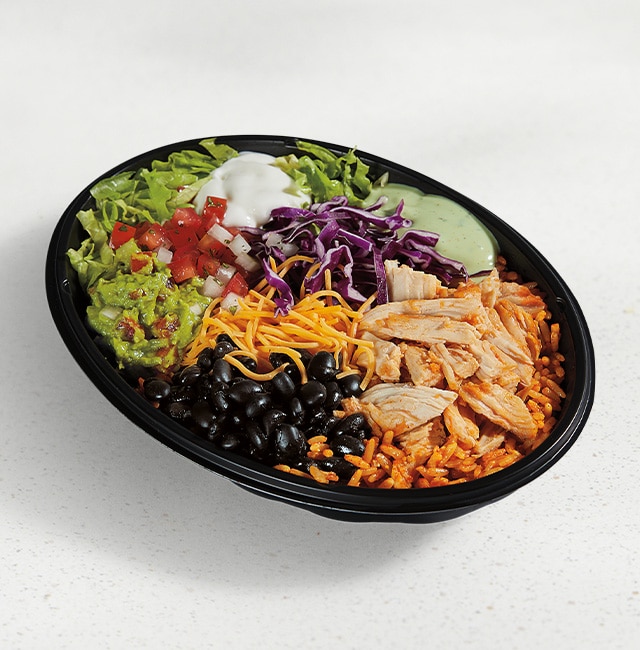
I’ve been impressed with Taco Bell lately. The Cantina Chicken menu includes items that have beans, pico, and purple cabbage for extra fiber and flavor.
Here are some of the foods that are diabetes friendly at Taco Bell:
- Cantina chicken bowl and unsweetened iced tea (total: 44 grams carbs, 25 grams protein, 24 grams fat)
- Cheese quesadilla with guacamole and pico added, water (total: 43 grams carbs, 19 grams protein, 28 grams fat)
- Two crunchy tacos with guacamole, pico, and purple cabbage added, plain iced coffee (total: 32 grams carbs, 16 grams protein, 26 grams fat)
Chick-Fil-A
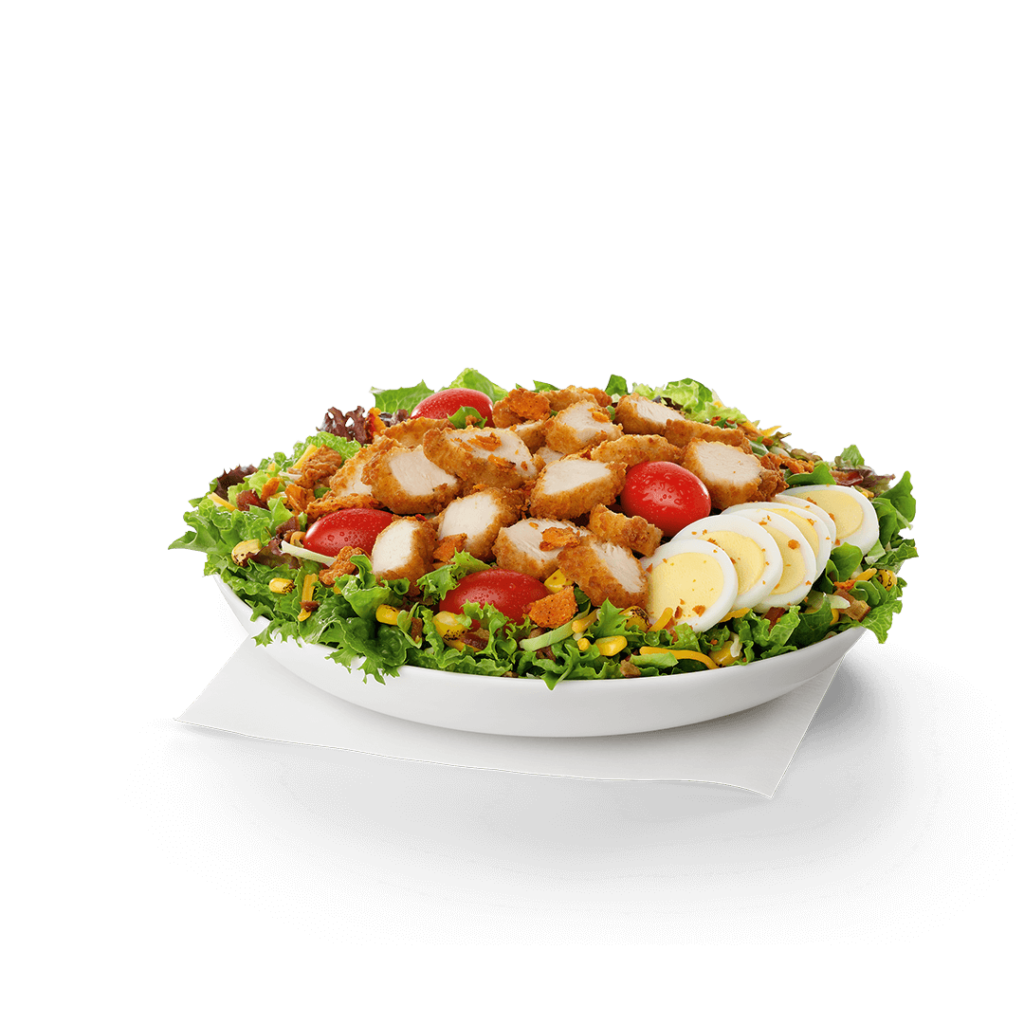
This is my all-time favorite, but I don’t have one where I live. It’s probably a good thing, as I’d probably be frequently hitting the drive-thru.
Besides excellent customer service, they’ve absolutely nailed the chicken nuggets. Plus, they have grilled options for those looking to reduce carbs and fat.
My picks for Chick-Fil-A are:
- Cobb salad with unsweetened iced tea (Fried nuggets: 28 grams carbs, 41 grams protein, 28 grams fat; Grilled nuggets: 19 grams carbs, 39 grams protein, 20 grams fat)
- Grilled chicken nuggets (8 ct) and waffle fries, water (total: 46 grams carbs, 30 grams protein, 27 grams fat)
- Grilled chicken sandwich with kale crunch side salad, unsweetened iced tea (total: 57 grams carbs, 32 grams protein, 24 grams fat)
Subway
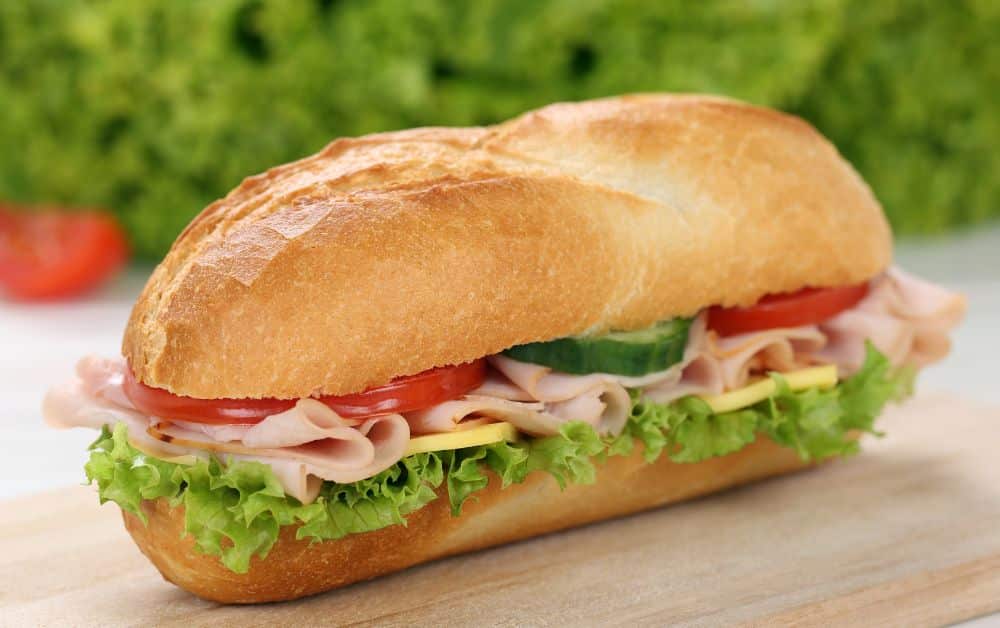
Subway is a nice break from your typical heavy, fried foods. Not to mention they have plenty of veggie add-ons.
You can pile veggies on your sub, or choose a salad.
Subway also has “No Bready Bowls” that are low in carbs. These are a nice option when you’re starting with high blood sugars, or if you’re wanting a higher carb food item, like dessert.
Here are my choices for diabetes-friendly Subway orders:
- Rotisserie-style chicken sub on whole grain bun (6-inch), Veggie Delite Salad (total: 49 grams carbs, 28 grams protein, 7 grams fat)
- Tuna salad with Loaded Baked Potato Soup (total: 41 grams carbs, 24 grams protein, 24 grams fat)
- Steak and cheese protein bowl and diet soda (total: 12 grams carbs, 42 grams protein, 19 grams fat) *because this is a low-carb meal, it may be a good one to add chips, cookie, or a small soda if that’s what you’re craving.
Domino’s
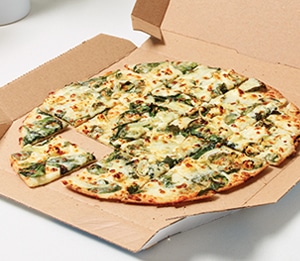
Pizza is a crowd favorite and is one of the most economical ways to feed your family fast food. You can still enjoy pizza if you have diabetes.
There are a few tricks to ordering pizza to be balanced. First, add veggies. Next, make it a thin crust and pair it with a side salad.
Domino’s has a lot of veggie options, and offers a side salad. Here’s what to order at Domino’s:
- Spinach and Feta thin crust (2 slices) and Classic Garden Salad with Coke Zero (total: 40 grams carbs, 23 grams protein, 34 grams fat)
- New York Style with ham, mushrooms, onions, green peppers, and olives (2 slices) with water (total: 62 grams carbs, 26 grams protein, 24 grams fat)
- Pacific Veggie Thin Crust (2 slices) with water (total: 36 grams carbs, 18 grams protein, 26 grams fat)
Wendy’s

For years, Wendy’s flew under my radar. Rarely did I go there growing up. But now that I have hungry teenagers, Wendy’s is in our fast food rotation.
Now, fast food isn’t something we eat regularly, but sometimes we have late games or out-of-town tournaments that require a meal on-the-go.
My young athletes love the “Biggie Bags”. It’s basically a grab bag assortment of their favorites—priced affordably. It’s a win-win.
However, not all of us need the “Biggie Bag”, me included. So here are some balanced choices at Wendy’s:
- Apple Pecan Salad with Pomegranate Vinaigrette Dressing and Minute Made Light Lemonade (total: 44 grams carbs, 29 grams protein, 24 grams fat)
- Jr. Cheeseburger with small fries and unsweetened iced tea (61 grams carbs, 18 grams protein, 26 grams fat)
- Large Chili with a Jr Frosty (62 grams carbs, 28 grams protein, 21 grams fat)
Kentucky Fried Chicken

KFC can be a bit tricky, since you don’t typically have your own portions. You are likely ordering family-style buckets of chicken and large sides.
Removing the battered skin will reduce your intake of salt and carbs. Think that’s the best part? Keep it on and aim for a veggie side like green beans or a side salad.
Remember, it’s all about balance. Keep in mind that one meal doesn’t determine your health. But if you’re looking to keep your blood sugar spike to a minimum after eating KFC, here are some options:
- Original Recipe Chicken Breast with small Mashed Potatoes and Gravy plus House Side Salad and water (totals: 34 grams carbs, 43 grams protein, 26 grams fat)
- Grilled Chicken Breast, small Macaroni and Cheese, Green Beans, and diet Dr. Pepper (totals: 22 grams carbs, 44 grams protein, 13 grams fat)
- Two Original Recipe Chicken Thighs with small Coleslaw and unsweetened iced tea (totals: 30 grams carbs, 39 grams protein, 50 grams fat)
Panda Express

While the food is often high in sodium, there are a lot of vegetable options when eating Chinese food.
So yes, you can eat Chinese food if you have diabetes. You just want to look for more protein and vegetable-based meals.
The rice is pretty high in carbs, so if you’re looking to stay within target range, you may need to fill up on other foods.
That’s not to say that you can’t have rice. If you love rice, then get the rice. Maybe eat half of an order rather than the whole thing—which brings the carb count from 80 grams to 40 grams per serving.
At Panda Express, they have a Wok Smart menu that offers dishes that are lower in calories and are loaded with veggies. You can use that as an ordering guide.
Some diabetes friendly orders at Panda Express could be:
- Grilled Teriyaki Chicken with Super Greens and water (totals: 24 grams carbs, 39 grams protein, 13 grams fat)
- Broccoli Beef and one Chicken Egg Roll (totals: 33 grams carbs, 15 grams protein, 17 grams fat)
- Wok-Fried Shrimp and Super Greens, diet soda (totals: 29 grams carbs, 23 grams protein, 8 grams fat)
Best fast food for people with diabetes
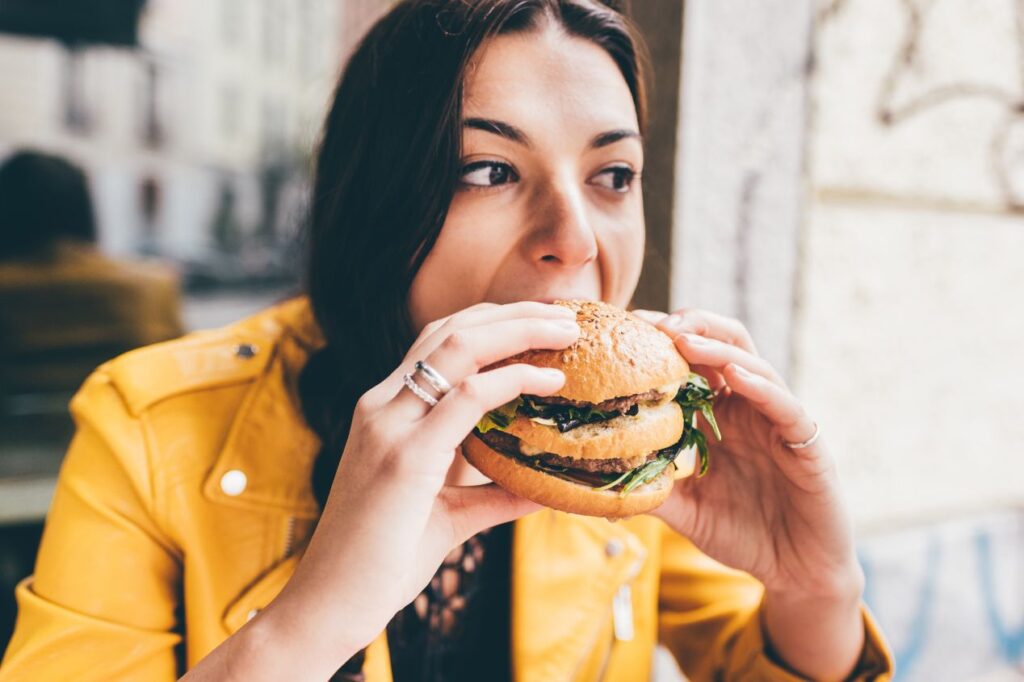
The best fast food for people with diabetes is the food you enjoy. There is no sense in me suggesting super low-carb foods that leave you craving more.
Eat what you love. Do it mindfully. Make it balanced. And above all, don’t feel guilty about it.
Fast food is a practical part of a busy person’s life. We all need help sometimes. Fast food can be the fuel we need to get through the rest of our day. It’s okay to eat it.
Do you need help choosing foods to optimize your blood sugars? Struggle with food guilt or allowing yourself permission to eat ALL foods? I can help.
Insurance often covers diabetes and nutrition education
I am now working with Nourish to accept insurance to make your nutrition appointment affordable. Click on the button below to start the process and see if your visit is covered by insurance.
Disclaimer: This information is intended as a self-help tool for your own use, at your own risk. My opinions do not reflect the values, thoughts, or opinions of the Academy of Nutrition and Dietetics or other professional health organizations.
About the author
Erin is a registered dietitian and diabetes educator with almost 20 years of experience. She specializes in weight-inclusive diabetes care and prevention, intuitive eating, fitness, and women’s health. She works as a consultant and writer in the health and wellness space. Erin is passionate about empowering people to manage their own health and to have peace with food.
